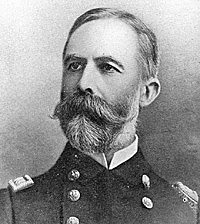 William T. Sampson was born in Palmyra, N. Y. February
8, 1840. His career is a striking example of what industry,
intelligence and courage can secure. Others of our prominent
naval officers have belonged to rich and influential families,
whose influence sometimes opportunely secured for them a
chance to make known their abilities. Admiral Sampson had none
of these advantages.
William T. Sampson was born in Palmyra, N. Y. February
8, 1840. His career is a striking example of what industry,
intelligence and courage can secure. Others of our prominent
naval officers have belonged to rich and influential families,
whose influence sometimes opportunely secured for them a
chance to make known their abilities. Admiral Sampson had none
of these advantages.
His father was a farmer in moderate circumstances and could not allow his son to devote all of his time even to the local schools, and he was frequently compelled to leave school to assist at home on the farm in the work there during the busy season. Handicapped as he was, nevertheless young Sampson soon distanced the rest of the boys at the Union School at Palmyra. A local Congressman, attracted by his intelligence and bright manner, secured for him an appointment at the naval academy, which he entered in 1857, and from which he was graduated at the head of his class three years later.
Serving off Charleston in 1865, he was ordered by the admiral to enter the harbor and remove or destroy all submarine mines and torpedoes by which the city was protected from- invasion. The service required was a difficult and dangerous one, and the work was conducted under a heavy fire from the enemy's sharpshooters. A number of his men being killed about him, Lieutenant Sampson ordered them under cover as much as possible, while he himself remained a target for their rifles, and calmly superintended the work.
While swinging in the current the "Patapsco" struck a submarine mine, which exploded and sent her to the bottom with seventy of her crew. Lieutenant Sampson was thrown about ioo feet by the force of the explosion, but was rescued with twenty- five of his men. His commanding officer, in the official report of the disaster, speaks in high terms of his lieutenant's coolness and bravery.
He was appointed Superintendent of the Naval Academy in 1886 and held this position until 1890. In 1892 he became Inspector of Ordnance and in 1893 was made Chief of the Bureau of Ordnance. While in that position he had charge of the manufacture of the heavy guns and tested the turrets and ordnance machinery connected with many of our battleships now under his command.
It is a striking compliment to Captain Sampson that he was placed at the head of the "Maine" Court of Inquiry, the President recognizing that a thorough knowledge of a ship from the bottom of her keel to the tip of her masts and a level head was of more value in that position than an ability to coin unique phrases.
When it became apparent that hostilities with Spain were about to break out the President appointed Acting Rear-Admiral Sampson to the command of the fleet. He transferred his flag to the cruiser "New York," kept the, fleet in perfect readiness, had Havana blockaded the afternoon of the same day the President issued the proclamation giving notice of intention to blockade that port.
The new navy owes a heavy debt to Admiral Sampson. He devised the superimposed turrets which are the distinctive feature of the battleships "Kearsarge" and "Kentucky." The great naval gun factory at Washington was constructed while he was Chief of the Bureau of Ordnance. In the navy he is regarded as a high authority on torpedo work, and his lectures at the War College produced a profound impression all over the world.
In personal appearance, Admiral Sampson is of slight build, blue eyes, shoulders a trifle rounded, with considerable gray in his hair and beard. He is a man of few words, but personally very well liked. He has the reputation of being cool, level-headed, full of resources, and a capital man to have about in an emergency, This son of what Lincoln loved to term the " plain people " has proved his right to a recognized position among our leaders.
Admiral George Dewey
Commodore Winfield Scott Schley
Admiral William T. Sampson
Captain Alfred Thayer Mahan
US Navy Pay Rates and Prize Money
Passing of Spain Chapters List
Back to List of One-Drous Chapters: Colonial
Back to List of All One-Drous Chapters
Back to MagWeb Master Magazine List
Magazine articles and contents are copyrighted property of the respective publication. All copyrights, trademarks, and other rights are held by the respective magazines, companies, and/or licensors, with all rights reserved. MagWeb, its contents, and HTML coding are © Copyright 1998,1999 by Coalition Web, Inc. This article appears in MagWeb (Magazine Web) on the Internet World Wide Web.
Other military history articles and gaming articles are available at http://www.magweb.com